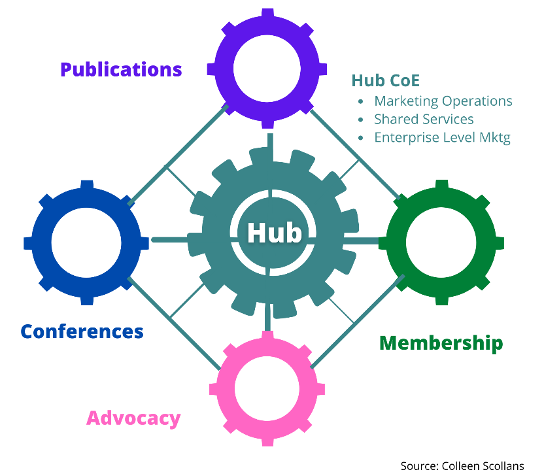
The optimal marketing organizational structure is a perennial hot button topic. As brands pivot to embrace modern marketing, the topic has never been more fertile. Since it is not as simple as overlaying marketing technology and new data-driven capability on existing marketing structures, organizational design needs to adapt (i.e. catch-up) to modern marketing.
One of the most common organizational design questions is around centralized marketing versus decentralized marketing. In a centralized marketing structure there is a single marketing team whereas in a decentralized structure there are separate marketing teams that report into different business units. While there might be some centralized roles (e.g., branding), in a decentralized structure, by and large, the various marketing teams operate as siloes.
Over the last decade, I have seen countless memberships organizations, publishers, and education companies wrestle with this core structural decision. It is such a vexing issue, that it is all too common for an organization to move to a centralized structure only to decentralize a few short years later or vice versa. As both models bring advantages, it is easy to see how organizations ricochet between the two options or become paralyzed by indecision.
The pros of centralized structures include:
- Improved Cost & Efficiency: Centralization drives economies of scale and standardization. This is especially important as marketing utilizes more costly and complicated technology, relies more heavily on data, and creates more high-impact content marketing assets (e.g. videos, whitepapers, etc.). Centralization minimizes costly duplication and siloes.
- Customer Experience: A true customer-centric orientation needs to transcend internal structures. For example, associations have customer overlap across their publishing, membership, and conference business units. Centralized marketing is well positioned to develop cross-product customer experiences, deliver customer-focused campaigns, and ensure customers are not inundated with too much communication.
- Talent Maximization: Centralized structures have more capacity to hire in specialist roles for the new skills required in modern marketing. Due to scale and best-in-class processes, centralized structures are better at retaining and growing talent. In addition, centralized structures train, share best practices, and foster cross-team collaboration. Marketing is a learning organization where continual improvement is required.
- Accountability & Measurement: Through centralized benchmarks, testing best practices, and a reporting infrastructure, central structures enable all of marketing to be data savvy and accountable.
- Consistent Brand: A strong central brand is a competitive differentiator. While it is common to have sub-brands (e.g., a Journal brand is an important sub-brand of the parent society brand), a unified brand architecture and strategy, across the entire organization, delivers the most value.
Compelling, right? Are you sold? Before you decide to pursue centralization, look at the pros of decentralized structures:
- Expertise: “Local” teams have domain expertise in the products, customers, and market dynamics of their specific business unit. It is hard to market effectively if you are not close to your customers’ needs.
- Agility: Because teams are smaller and closer to the market, they can respond more quickly to seize business opportunities. For example, if you are launching a new OA journal, the journal marketing team can fully pivot to this new priority.
- Customization: In decentralized structures, there is more opportunity to customize for customer and market needs. Sometimes centralized structures force blunt or generic approaches for the stake of standardization.
- Stronger alignment: In a decentralized structure, the marketer is embedded and highly collaborative with their business unit colleagues. The marketer is an integral part of the business unit’s leadership team.
See the problem? Decentralized structures are equally attractive. Viewed through the binary lens of these two divergent, and yet equally compelling options, it is easy to see why it is often so difficult to choose.
Luckily, there is another option: a hub and spoke model. The question is not, “should I centralize or decentralize my marketing structure,” but rather, “how do I get the benefits of both structures?”
“In my opinion, it’s time for us to move away from this pendular debate. It’s unhelpful, muddles the conversation, and orients too many marketing leaders to think in “either/or” terms. What they need to understand is that modern marketing organizations require a “both/and” approach.”
— Marc Brown for Gartner
A hub-and-spoke structure is the epitome of a “both/and” scenario. The hub is the catalyst that fuels the best of centralization while the spokes deliver the best of decentralization. The mechanics of a hub-and-spoke structure are as the visual implies. The spokes, representing the various marketing teams, are connected through a central hub. The hub is a center of excellence (CoE) that facilitates marketing excellence through shared services, marketing operations, and enterprise level marketing.

Hub-and-spoke models have been tried in the past with varying degrees of success. The difference, and why today’s hub-and-spoke marketing structures work so well, is the emphasis on Marketing Operations (MOPs).
“Marketing operations is certainly not the sexiest part of marketing, but it is becoming the most important one.”
David Edelman and Jason Heller for McKinsey
The modern incarnation of Marketing Operations is a newer phenomenon. MOPs evolved in response to the increased focus on the customer, the importance of marketing accountability, the need for marketing specialization, and the Cambrian rise of marketing technology. Marketing Operations accelerates marketing effectiveness and efficiency through a focus on people, processes, data, and technology.
At a high-level, MOPs focus on the following areas:
- Infrastructure: Marketing technology (MarTech) and data management.
- Analytics & Measurement: Analytical and reporting best practices and expertise.
- Intelligence: Insights and intelligence about customers, competitors, and the market.
- Planning: Departmental planning processes (strategic, budgetary, campaign, etc.) as well associated workflows, and content / creative operations.
- Marketing Enablement: Training & skills development, process optimization, and project management support and expertise.
- Customer Targeting & Orchestration: Expertise and governance to effectively utilize customer data for segmentation, personalization, orchestration, and marketing automation.
In addition to Marketing Operations, “Shared Services” and “Enterprise Marketing” reside in the hub. Shared services teams provide access to resources that the business unit alone could not afford or where it would be inefficient to split highly specialized resources (e.g., SEO specialists). Enterprise Marketing includes teams, such as branding and communications, that are focused on top-level organizational strategies and channels (e.g., an organization’s main web site).
Embedded in the business units, the spokes oversee the marketing strategy and execution for their specific business unit. To other team members in the business unit, the “spoke” marketing team feels fully dedicated and focused on their goals.
While the spokes are largely focused on the parochial demands of their business unit, the hub, through the marketing operation team, ensures coordination, alignment, and collaboration across all of marketing. In addition, MOPs, as a center of excellence, infuses the full marketing team with new technology-enabled capability, training, and best practices.
In a hub-and-spoke structure, the hub reports to a head of marketing, usually a CMO (Chief Marketing Officer). The spokes report to their respective business unit head and have a connection to the CMO through a second reporting line. The quality of this marketing leader, the support they receive, and their ability to balance the best of centralized with decentralized, is another critical hub-and-spoke success ingredient.
The pivot to a hub-and-spoke structure is not as simple as shifting reporting structures. Hubs come in different shapes and sizes depending on an organization’s strategy, scale, and culture. For some organizations, it is a single role and for others it is a sizable team. The most important first step is the formation of your marketing operations core. An experienced marketing consultant can help build your MOPs strategy, business case, and recommend the right infrastructure to meet your business objectives.
While the shift to hub-and-spoke is not without challenges, the benefits can be well worth the effort. The hub-and-spoke model balances efficiency and effectiveness while remaining agile and customer focused. When executed well, the hub-and-spoke improves marketing and customer metrics. Further, it can unlock cost savings as technology, processes, and teams are streamlined and data guides decision making across all functions. And last, but not least, a well-designed hub-and-spoke marketing structure puts an end to the circular centralized versus decentralized debate.
Related Services:



